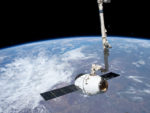The Ice-cream freezer is invented, the first 3D cartoon premiers and a dragon flies to the space station… It all happened This Week in Tech History.
This Week in 1848 – William Young of Baltimore, MD patented a hand-cranked paddle freezer and invented the technique that survives today. It cut the time from hours to minutes and resulted in a uniform and smooth ice cream. And it brought the frozen confection to many more people. Before his invention, making ice cream was a feat of strength. A smaller bowl of cream, milk and sugar was placed in a larger bowl of ice. The ice was salted to make it colder, and a servant beat the mixture until his arms gave out. Then another would take over, then another.
1929 – Warner Brothers debuted the first all-color, all-talking motion picture. The film debuted at the Winter Garden Theatre in New York City. Ethel Waters, Joe E. Brown and Arthur Lake starred in “On With the Show”. The film generated a lot of buzz in Hollywood and virtually overnight, most other studios began shooting all-color films. Unfortunately, the original color print of On with the show was lost and only black and white copies remain. One of which is held in the Library of Congress.
1953 – The first 3-D (three-dimensional) cartoon premiered at the Paramount Theatre in Hollywood, California. The production, a Walt Disney creation/RKO picture, was titled, “Melody”. It involves an owl teaching his class full of birds about music and melody. The 3D process never really caught on with theater audiences because of the need to wear the polarized glasses, but the show remained a novelty at Disneyland for several years.
And this week in 2012 – The SpaceX Dragon became the first commercial spacecraft to rendezvous with the International Space Station. Before this only four governments, the US, Russia, Japan and the European Space Agency had accomplished this feat. SpaceX began developing the Dragon spacecraft in late 2004. Elon Musk, CEO of SpaceX, reportedly named the spacecraft after the 1963 song “Puff the Magic Dragon” by Peter, Paul and Mary as a response to critics who considered his spaceflight projects impossible.





